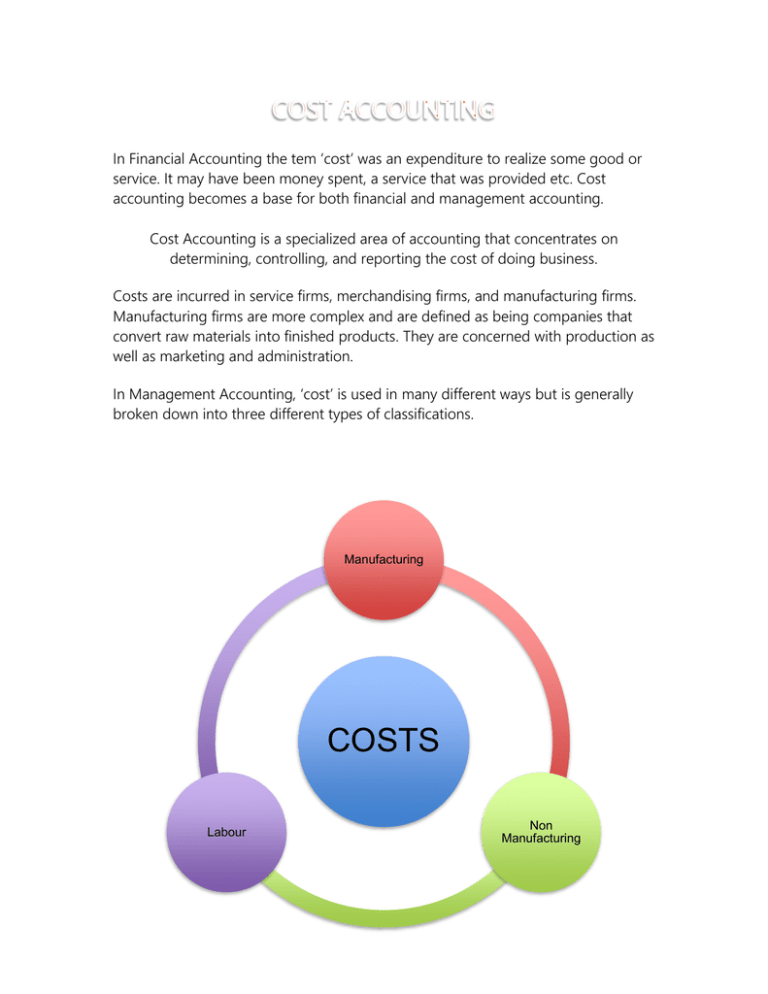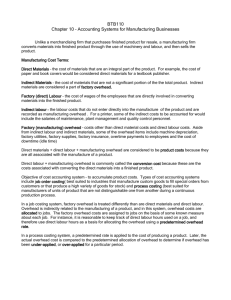cost accounting - Mr. LeBlanc's Classes
advertisement

In Financial Accounting the tem ‘cost’ was an expenditure to realize some good or service. It may have been money spent, a service that was provided etc. Cost accounting becomes a base for both financial and management accounting. Cost Accounting is a specialized area of accounting that concentrates on determining, controlling, and reporting the cost of doing business. Costs are incurred in service firms, merchandising firms, and manufacturing firms. Manufacturing firms are more complex and are defined as being companies that convert raw materials into finished products. They are concerned with production as well as marketing and administration. In Management Accounting, ‘cost’ is used in many different ways but is generally broken down into three different types of classifications. Manufacturing COSTS Labour Non Manufacturing MANUFACTURING COSTS: Manufacturing Costs are broken down further into three types. Non Manufacturing Manufacturing OVerhead Direct Material Manufacturing Costs 1. Direct Material – All items such as raw material, standard and specialized parts, and sub assemblies required to assemble or manufacture a complete product. Direct material costs are assigned to a specific work order. 2. Direct Labour- work that is an essential part of a production process that is a provision of a service can be directly traced to a certain product or project. EXAMPLES: factory worker salaries, accountant wages in an accounting firm. 3. Manufacturing Overhead- also known as factory overhead, factory burden or production overhead involves a company’s factory operations. It includes the costs incurred in the factory other than the costs of direct materials and direct labour. This is the reason that manufacturing overhead is often classified as an indirect production cost. EXAMPLES: Depreciation or rent of the factory or building, depreciation on factory equipment, supervisors in the factory, quality control department, maintenance employees wages, electricity and gas for factory, indirect factory supplies. NON-MANUFACTURING COSTS: Non-manufacturing costs can be broken down into two separate types: Marketing or Selling Costs Administative Costs NonManufacturing Costs 1. Marketing or Selling Costs – Include all costs needed to get the product into the hands of the customer. EXAMPLES: Advertising, shipping, sales travel, commissions, salaries etc. 2. Administrative Costs – Include all costs that cannot be directly included in the manufacturing costs, marketing or selling costs. These costs tend to serve the whole organization, not just manufacturing, sales etc. EXAMPLES: General Accounting, Office Support Staff, Public Relations, Etc. LABOUR COSTS: As technology changes, overhead is becoming the fastest growing expenditure while direct labour costs are decreasing. In some instances, they may be lumped together and treated as a conversion cost. CONVERSION COST: the sum of direct labor and production overhead costs of manufacturing products. The cost of raw materials used ot make products is not included in the definition. Genreally speaking, this is a rough measure of the value added by the manufacturing process. However, to understand and control labour costs, the following breakdown will help : Direct Labour In-Direct Labour Labour Costs 1. Direct Labour - can be directly traced to a certain product or project. EXAMPLES: factory-worker salaries, accountant wages in an accounting firm. 2. Indirect Labour (not directly traceable). Examples: janitors, supervisors, materials handlers, engineers, security guards, maintenance workers, etc. A further breakdown of indirect labour costs include idle time, overtime premiums, and labour fringe benefits. These will be discussed below: Idle time -is the workers' time that accumulates during machine breakdowns, material shortages, power failures, receiving directions from superiors, etc. Idle time may not be assigned to one job, but as part of manufacturing overhead to be assigned to all production. Can idle time be prevented or reduced through good planning? How much idle time should be built into a plan? Overtime premium- If overtime can be directly identified with one project or product, it becomes a direct cost. Because jobs are completed in a random order, overtime becomes indirect labour costs instead of direct labour. Should we assign all the overhead costs to a job just because it was worked on at the end of the day when the overtime was put in? Should overtime be built into a management plan? What is more important -- meeting deadlines or incurring additional labour costs? Can a concern for human resources enter into this discussion? Labour fringe benefits- employment costs paid by the employer. These are hidden costs to the employee and the public. The cost of employing a person does not end at the amount of gross wage as is seen in previous classes. The employer must match Canada Pension Plan (CPP), contribute to Employment Insurance (EI) and Workers' Compensation, and may contribute to company pensions, hospital plans, etc. Firms usually treat these costs as manufacturing overhead but may assign a portion to direct labour. Indirectly these costs are charged back to the consumer in the manufacturing overhead. Labour and overhead combined are called the conversion costs of the firm. The conversion cost may be considered the cost of taking an original product and modifying it into a final product. Cost Accounting – Questions 1. What is cost accounting? (2 Marks) 2. Name three categories which are used to classify costs define each and provide examples (9 Marks) Category Definition Example(s) 3. Compare and contrast non-manufacturing costs and overhead. Are they same thing? Why or why not? (3 Marks) 4. Why is the cost of overhead continuing to rise for all businesses? 5. Why is the cost of direct labour continuing to increase? 6. Research employee benefits and employer contributions such as tax, EI, CPP, ICP Disability, Union or Federation Fees. How would these effect the overhead of a business?






